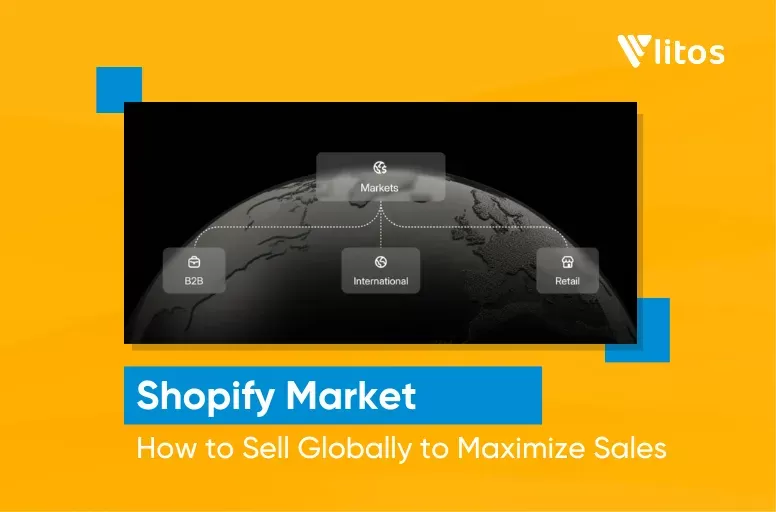
Shopify Markets: How to Sell Globally from a Single Store
Selling across borders used to mean setting up multiple storefronts, dealing with duplicate administrative work, and piecing together apps for currency, language, and tax compliance. Shopify Markets addresses this by allowing you to manage global expansion in one place, eliminating the need to create multiple versions of your store.
With the 2025 updates, Shopify has restructured how Markets works, adding support for parent/sub-markets, catalog controls across plans, and new limitations by plan tier.
In this guide, we’ll cover:
- What is Shopify Market, and all the highlight features
- Benefits of using it
- And how to set up Shopify Markets correctly
Let’s get started!
What Is Shopify Markets? (And How It Compares to Other Global Selling Options)
What is Shopify Markets?
Shopify Markets is a built-in solution that enables you to manage global selling from a single store. It handles localization – including currency, language, product availability, taxes, duties, and regional domains – without requiring the need to run multiple storefronts.
In early 2025, Shopify restructured how Markets works:
- Merchants can now group countries into parent/sub-markets, inheriting shared settings while customizing key details per region.
- Product catalogs are now easier to manage across markets and are no longer exclusive to Plus.
- However, some features have been removed from the Basic plan, like market-specific pricing and multi-market management.
Shopify also rolled out updates to the Markets and Catalogs APIs, requiring apps to use version 2025-04 or higher. This change supports new features, such as submarket inheritance and catalog unification, and ensures compatibility with the latest Shopify Markets API framework.
What is Managed Markets (formerly Markets Pro)?
Managed Markets is Shopify’s done-for-you international selling option, available to select U.S.-based merchants. Instead of handling taxes, duties, and compliance yourself, Shopify (via its partner Global-e) acts as the merchant of record, managing regulatory, payment, and shipping complexity for you. It’s deeply integrated with Shopify Markets but offloads much of the legal and operational overhead.
What are expansion stores?
Expansion stores are separate Shopify stores created for each region or market. You manage them independently, with distinct product catalogs, themes, pricing, languages, and marketing strategies per store. This gives you full control, but also means more work: more logins, more apps, more maintenance, and often, more cost.
Here is a brief comparison among Shopify Markets vs Shopify Managed Markets vs expansion stores:
| Criteria | Shopify Markets | Shopify Managed Markets (Markets Pro) | Expansion Stores |
| Setup complexity | Low | Low (but restricted access) | High |
| Admin structure | Unified | Unified | Separate per store |
| Duties & taxes handling | Manual or via apps | Handled by Shopify/Global-e | Merchant-managed |
| Local payment methods | Limited to Shopify Pay | Extensive via Global-e | Custom per region |
| Currency conversion | Real-time FX rates | Locked rates (30 days) | Manual or app-based |
| Product catalog control | Centralized | Centralized | Independent |
| SEO flexibility | High (hreflang support) | Medium | High |
| Customization level | Moderate | Low | High |
| Maintenance effort | Low | Low | High |
For most merchants, Shopify Markets is the right starting point. It’s flexible enough for real international growth, yet lean enough to manage from a single admin. You gain control over currency, language, pricing, and product visibility – without the overhead of expanding into new stores or the legal complexity of a merchant-of-record model.
That said, we recommend Managed Markets only if you’re US-based, shipping at scale, and want Shopify/Global-e to handle taxes, duties, and compliance. Expansion stores still have their place, but usually when you’ve outgrown the limitations of Markets. But if you’re testing global demand or scaling up existing markets? You should definitely start with Shopify Markets and set it up right from the beginning.
Benefits of Using Shopify Markets
Shopify Markets is a framework for running your global business without the usual overhead. Instead of spinning up multiple storefronts or juggling third-party tools, you get one centralized system to sell in different regions, adapt to local preferences, and scale efficiently.
1. Manage global sales from one admin
You don’t need separate logins, store setups, or dashboards. Shopify Markets lets you manage multiple regions – currencies, languages, product availability, tax rules – from a single Shopify admin. One backend, one catalog, global reach.
2. Simplify operations with centralized settings
Instead of duplicating effort per region, you define market-specific rules for pricing, shipping, taxes, and content in one place. This keeps your workflows tight and reduces the risk of inconsistencies between regions.
3. Improve customer trust and conversions internationally
Customers shop with more confidence when they see local currency, language, payment methods, and transparent landed costs. That reduces cart abandonment and improves your conversion rate in non-domestic markets.
4. Enable faster international expansion without multiple stores
Markets makes it easier to launch into new regions without overhauling your architecture. You can test demand in new markets quickly and double down where traction picks up.
Note: Shopify’s 2025 updates to Markets introduced more granular control (like submarkets and shared catalog logic), but also tightened access to advanced features. If you’re on the Basic plan, certain functionality – such as managing multiple markets or adjusting pricing by region – now requires an upgrade to Grow ($105/month) or a higher plan.
All The Highlight Features Of Shopify Markets
Now that you better understand this suite, let’s see what Shopify International has to offer!
1. Allow checkout in local currencies
Shopify Markets lets international customers browse, pay, and get refunded in their local currency, with real-time exchange rates powered by Shopify Payments. You can also enable rounded pricing for a more familiar, localized experience (e.g., $19.99 instead of $19.38), helping increase buyer confidence at checkout.
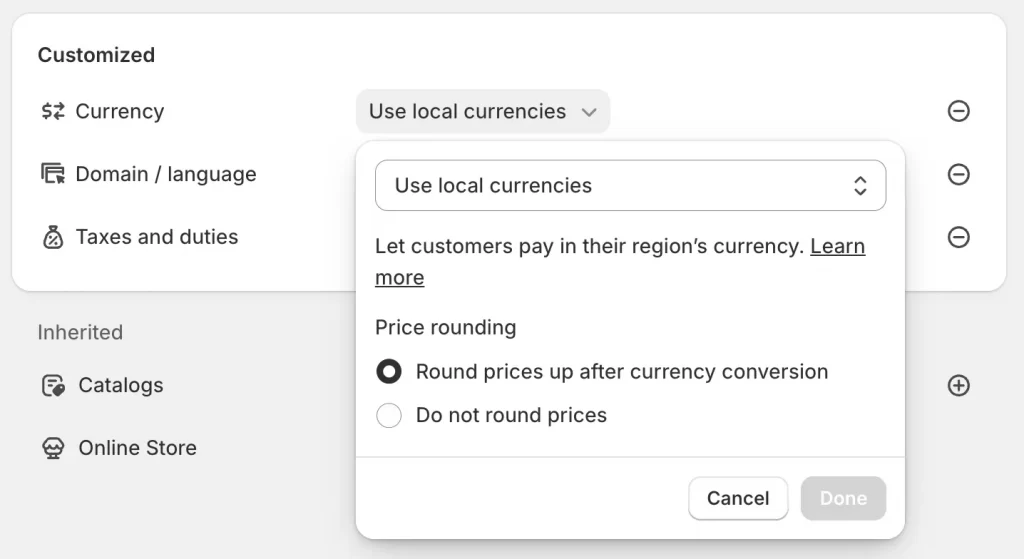
2. Empower customers to shop in their local languages
Did you know 76% of people like to buy things that have information in their own language? (Source: CSA Research)
Markets supports localized language experiences using Shopify’s Translate & Adapt app or third-party tools like Transcy. You can translate your storefront into 160+ languages, making it easier for global customers to navigate your store and complete purchases.
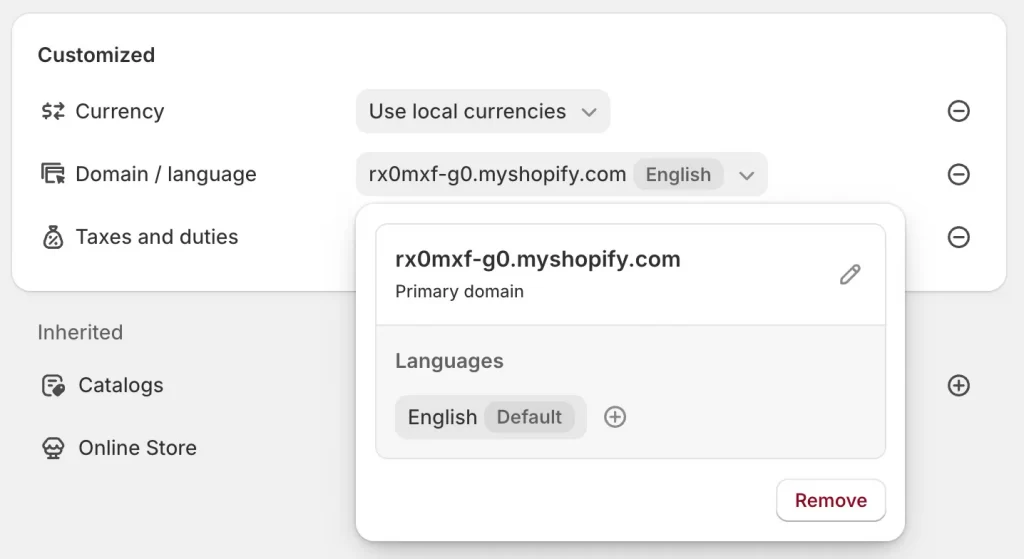
3. Offer local payment methods
While credit cards offer a familiar payment option, catering to local preferences is crucial for a seamless international shopping experience. For example, here are some preferred payment methods in some specific regions:
- Europe: 80% prefer digital wallets like PayPal or Alipay;
- Netherlands: Bank transfers reign supreme;
- Latin America: Cash-based options like Boleto Bancário (Brazil) are common.
With Shopify Markets, you can not only enable customers to shop in their local currencies but also check out in their preferred payment method.
Specifically, Markets auto-incorporates the most popular payment method of a specific country or region into your checkout process. For instance, if your European market is exclusively set up for Belgium, Bancontact will be offered as a payment option.
4. Adjust pricing for different markets
One of the standout features of Shopify Markets is the ability to adjust pricing for different international markets directly from your Shopify admin. This feature allows for strategic pricing adjustments to better align with local market conditions.
For example, if you’re selling a line of eco-friendly water bottles, you might price them at $30 in the U.S. market. However, for your market in Europe, considering higher VAT rates and the cost of shipping, you might want to adjust the price to $40 to maintain your profit margin.

5. Use country-specific subdomain
Shopify Markets simplifies the process of creating a domain for a specific region by automatically generating subfolders for each new market you set up.
For instance, your main store could be myshop.com, while a version of your store specifically for France could be found at myshop.com/fr. Alternatively, you can use a subdomain (like fr.myshop.com) or a country code top-level domain (such as myshop.fr), depending on what suits your needs best.
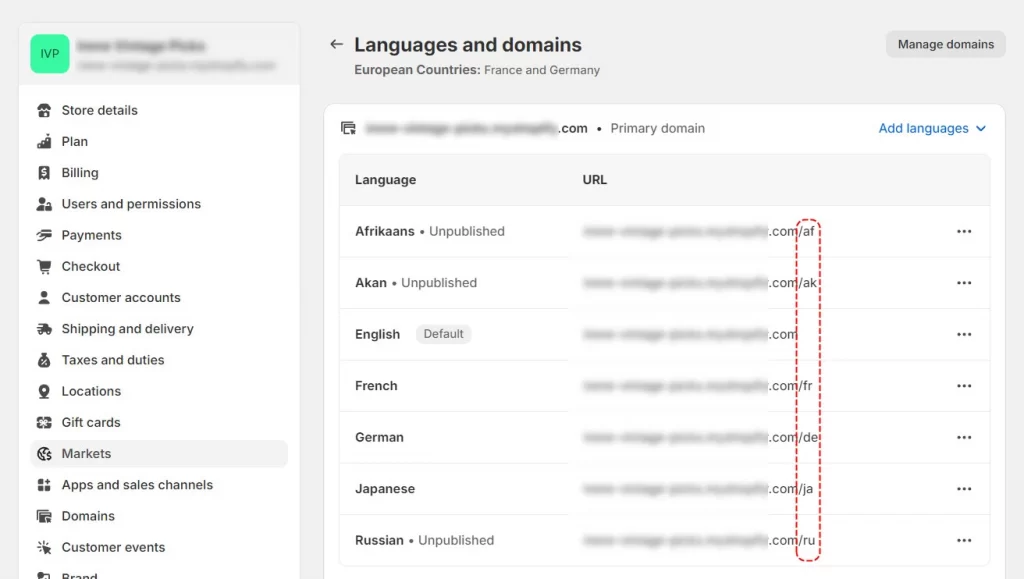
No matter which option you choose, Shopify Markets sets the appropriate SEO tags to ensure that your international customers find the correct domain when they search online.
The awesome part is that when a visitor visits your store, Shopify Markets will auto-detect their geolocation and show them the right domain.
6. Automatically calculate and collect duties directly at checkout
One of the biggest friction points in international eCommerce is uncertainty surrounding additional fees. If a customer doesn’t know whether they’ll be charged duties on delivery, they’re more likely to abandon the cart, or worse, refuse the shipment or issue a chargeback.
Shopify Markets helps you solve this by showing duties and import taxes upfront at checkout, so there are no surprises after the sale. With the built-in calculator, you can:
- Ensure total cost transparency: Customers see a clear breakdown of what they’ll pay, including duties, before they complete the purchase.
- Reduce refusals and chargebacks: Pre-collecting duties means fewer surprise costs at delivery, leading to smoother fulfillment and fewer complaints.
- Automate compliance across regions: The calculator adapts to each country’s tax rules and rate changes, so you don’t have to manage them manually.
This feature plays a big role in building trust with international buyers and making global selling more predictable for your team.
How to Set Up Shopify Markets
Shopify Markets enables you to manage and customize your store for different countries and regions, making it easier to expand your international sales. Here’s a step-by-step guide to setting up Shopify Markets:
Step 1: Access Markets in your admin
As of 2025, Markets now appears directly in Shopify’s main navigation, alongside Products, Orders, and Marketing.
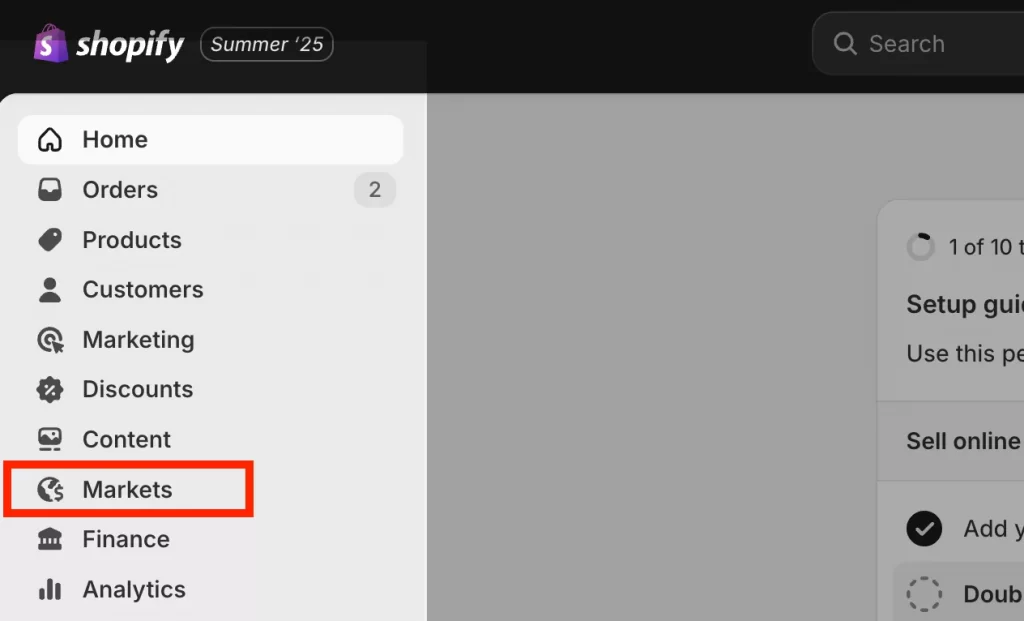
Click Markets to open your global selling dashboard. From here, you’ll see your default market (usually your home country) and any existing international markets you’ve created.
This move out of “Settings” reflects Shopify’s emphasis on internationalization as a core part of store operations.
Step 2: Create a new market
Click the “Create Market” button in the top right.

You’ll be prompted to:
- Name the market (e.g. “International” or “Europe”)
- Define which countries or regions it includes. Example: Add Australia, Austria, Belgium, and more as shown
- Set the status to Active or Inactive (you can toggle this later)
You can now also preview the market hierarchy, especially useful if you’re using parent/sub-market structures for shared rules with localized overrides.
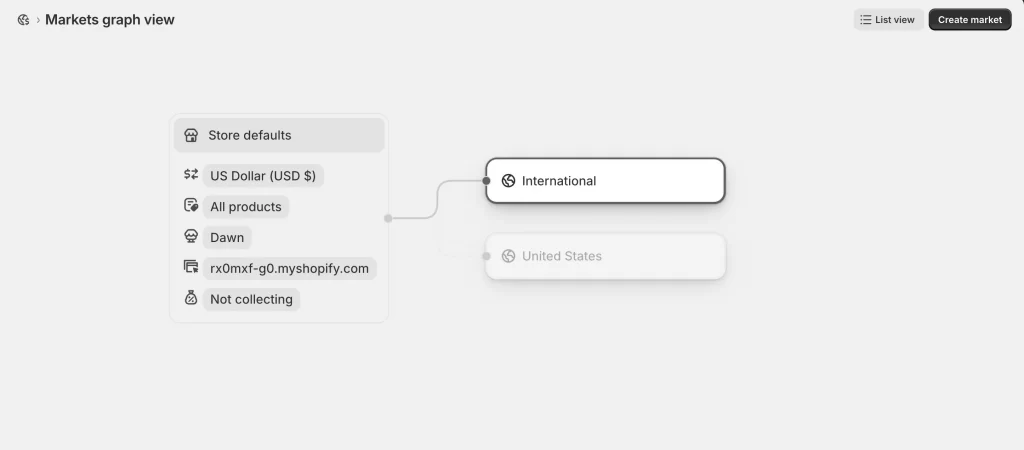
Step 3: Configure your market settings
Once created, each market can either inherit default settings or be customized:
- Currency: Choose local currencies or set custom price adjustments (Grow plan or higher)
Catalogs: Control which products appear in this market - Domain & Language: Assign a subfolder (like /fr) or a custom domain (like .co.uk) and language
- Duties & Taxes: Enable Shopify’s calculator to show total landed costs at checkout
- Theme/Online Store: Confirm which theme this market inherits (default is your live store theme)
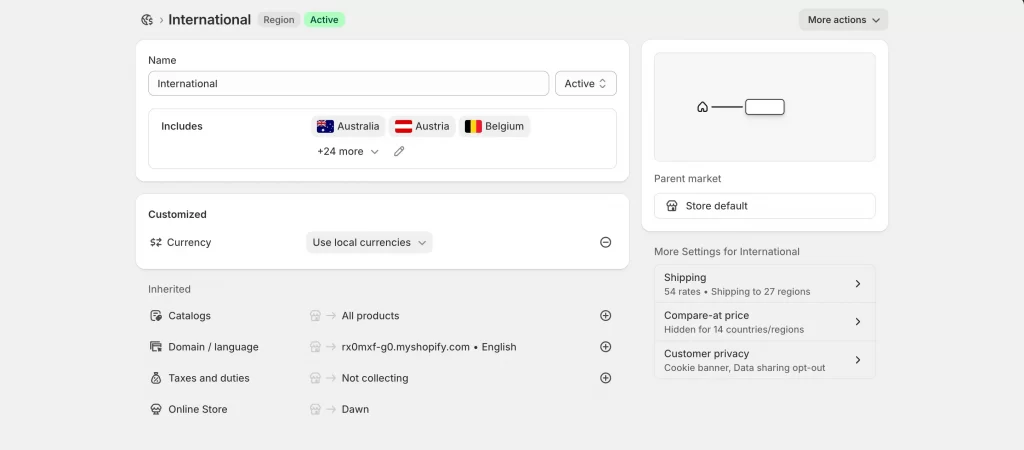
Additional configuration options appear in the “More Settings” panel, including shipping rates, compare-at price visibility, and regional privacy rules (e.g., GDPR banners).
Step 4: Activate and manage your market
When everything’s ready, set the market status to “Active” and click Save.
From there, Shopify will start applying your configurations live. You can monitor how each market performs and edit settings anytime.
⚠️ 2025 reminder: Shopify’s Geolocation app is deprecated as of March 2025. To redirect visitors automatically or localize based on browser language, use Shopify’s built-in domain redirection (unless you’re using an EU top-level domain – in which case, you’ll need a third-party solution).
Shopify Markets Limitations
Shopify Markets simplifies global selling, but it’s not a perfect fit for every business model. Some limitations – especially around legal structure, fulfillment, and platform dependencies – still lead brands to choose expansion stores or Shopify Plus-level setups.
1. Shopify Payments is required for core features
Markets depends on Shopify Payments to support local currencies and region-specific payment methods. If your country isn’t supported by Shopify Payments, you’ll lose access to key features like multi-currency checkout and local wallets – limiting the customer experience in those regions.
2. One legal entity per store
Shopify Markets doesn’t support linking different markets to different legal entities. If you operate under separate businesses in different countries, you can’t split tax handling or payment remittance accordingly. In this case, multiple Shopify stores (via expansion stores) are still required.
3. Markets are defined by country, not region
Markets can only be created at the country level, which limits flexibility for targeting specific regions within a country. For example, you can’t create a different experience for Puerto Rico vs the mainland US or Canary Islands vs mainland Spain.
4. No stock allocation or warehouse routing by marke
Currently, you can’t allocate inventory or route orders by market natively within Shopify Markets. This can create fulfillment inefficiencies if you have multiple warehouses serving different regions, and need better control over which stock gets shipped where.
5. Some features still incur costs or compatibility issues
- Currency conversion fees apply when converting foreign payments to your store’s base currency.
- Some third-party apps (especially around pricing, segmentation, and logistics) may not yet be fully compatible with the Markets structure.
- Tax, duty, and customs logic still requires care — and may need tools like Managed Markets to fully automate.
FAQs
What are the markets on Shopify?
Markets in Shopify refer to predefined customer regions (such as countries or country groups) that you can configure individually. Each market can have its own currency, language, pricing rules, product availability, and domain – all managed from a single Shopify store.
Is Shopify Markets free to use?
Yes, Shopify Markets is included in all Shopify plans; however, the features you receive depend on your subscription level. Shopify Markets pricing is tied to your plan: core features like currency and language settings are available on the Basic plan, but custom pricing, multiple active markets, and localized catalogs now require the Grow plan or higher.
Can I use Shopify Markets on the Basic plan?
You can, but with limitations. Merchants on the Basic plan can only manage their primary market and will not have access to features such as market-specific product catalogs, pricing adjustments, or multiple market groups. These are now restricted to Grow, Advanced, and Plus.
Who is eligible for Shopify Managed Markets?
Shopify Managed Markets (formerly Markets Pro) is available to eligible U.S.-based merchants. It’s designed for stores that want Shopify (via Global-e) to handle compliance, taxes, duties, and local payments – using a merchant-of-record model.
How does Shopify Markets impact SEO and domains?
Shopify Markets supports localized subfolders or domains (such as yourstore.com/de or yourstore.co.uk) and automatically adds hreflang tags to help search engines display the correct version to each region. This improves international SEO while keeping your site centralized.
What are the alternatives to Shopify Markets?
If Markets doesn’t meet your needs, you can consider: Expansion stores: Multiple Shopify stores for each region (more control, but higher maintenance) Third-party apps: For specific needs like language switching or country-based redirection Managed Markets: A fully managed international model, but limited to U.S. merchants
Final Words
Shopify Markets provides the infrastructure to scale globally without needing to set up multiple stores. For most merchants, it’s the fastest way to localize currency, language, pricing, and compliance, all from one admin. With the 2025 updates, it’s more structured and powerful than ever (even if some features are now available only behind higher-tier plans).
If you’re testing international demand, launching into new regions, or just tired of managing store clones, Markets is your most efficient move. Set it up right from the start, and it’ll scale with you.
At LitOS, we help brands roll out Shopify Markets the smart way – localized UX, clean architecture, and a growth-ready setup. Talk to us if you’re planning to go global and want to get it right!

